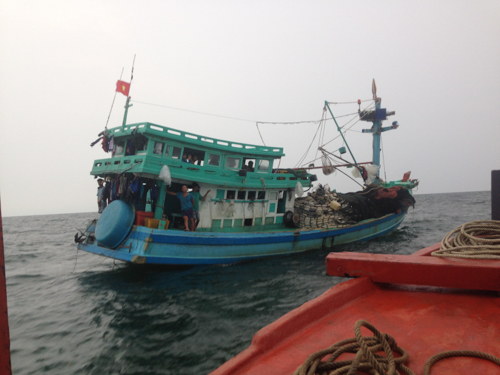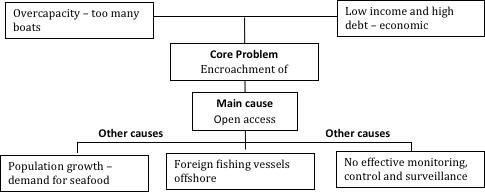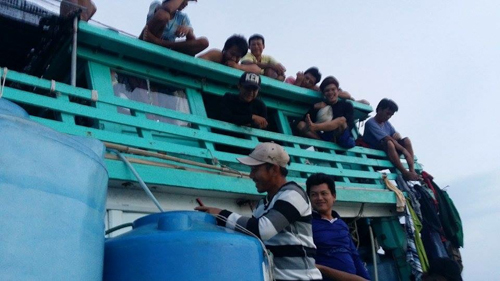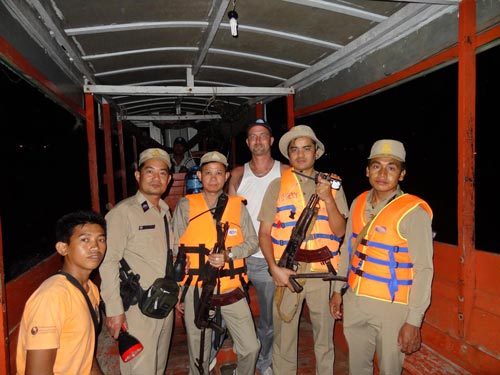
Illegal:
Illegal fishing refers to activities that are in violation of regional, state, national or international laws/obligations. This includes foreign or national vessels operating without permission in waters under the jurisdiction of a State, or against the relevant measures adopted by a RFMO. Illegal fishing in Cambodia has two sources; foreign and domestic. Both sources mainly occur in the form of destructive fishing techniques (e.g. pair trawling and electric trawling). Foreign vessels fishing without authority from their own flag State are also considered to be acting illegally. Domestic vessels which utilise mesh sizes below the minimum legal limit, banned fishing gear, or that lack registration or a license required to fish, are acting unlawfully. Furthermore, despite its alarming frequency, trawling in waters shallower than 20 metres is a criminal act.
Unreported:
Unreported fishing refers to those which have not been reported, or have been misreported, to the relevant national authority, in contravention of national laws and regulations. Additionally, it refers to the lack of reporting, or the misreporting, of fishing activities to the relevant RFMO, in contravention of the reporting procedures of that organization. Unreported fishing in Cambodia mainly refers to Thai and Vietnamese vessels that fish in Cambodian waters, as well as the lack of reporting of IUU fishing to the relevant authorities. Furthermore, the purposeful negligence of catch quotas and the misreporting of catch quantity/species is classed as unreported fishing.
Unregulated:
Unregulated fishing activities include those conducted in areas or targeting marine stocks where no relevant conservation and management measures are in place. Fishing activities that are carried out in a manner inconsistent with State responsibilities for the conservation and management of marine resources under international law, are also considered unregulated. Finally, vessels performing fishing activities within the domain of an RFMO without displaying nationality, or flying the flag of a State not party to the RFMO, are considered to be carrying out unregulated activities. Some examples of unregulated fishing in Cambodia include the large proportion of Cambodian boats without license or registration, open access fisheries and foreign vessels freely fishing in Cambodian waters with no impact assessment.
Other forms of IUU fishing activities include (Funge-Smith; SEAFDEC Secretariat 2016):
– Catching of prohibited or protected species.
– Fishing with a fake license, registration or vessel numbers.
– Registered boats that do not follow the relevant vessel specifications detailed in registration.
– Vessels carrying more than one flag, fishing in waters outside the permitted or designated fishing areas.
– Landing of fish in unauthorized ports or across borders.
– Transfer of catch at sea.
Clearly, IUU fishing can arise in an enormous variety of forms, whether through unlawful method, catch, documentation, vessel specifications etc. Numerous factors that catalyse the development of IUU fishing will be discussed, for instance overcapacity, low relative risk of punishment and open-access fisheries.

Factors leading to IUU fishing:
Overcapacity of fishing vessels is a major driver of IUU fishing in Cambodia (Funge-Smith). Marine resources are in decline and struggling to replenish due to frequent and intense fishing pressure. In this situation, fishers may be induced to utilise illegal and destructive fishing methods out of desperation for sparse marine resources. These methods are indiscriminate and frequently result in the capture of non-target species, which are composed mostly of prematurely caught juveniles (Ahmed & Chanthana 2015). For example, socio-demographic surveys conducted by MCC during August 2015 at Prek Tanean revealed that trawler by-catch can be higher than 80%, and also consists of habitat such as seagrass and coral. Catching low quantities of commercial species perpetuates overfishing, creating drastic declines in marine populations. Following this, illegal and destructive techniques may be used in an effort to capture scarce commercial species. Finally, this reduces population numbers further and destroys habitats, once again increasing the level of fishing intensity and fulfilling a perpetual cycle of ecosystem destruction. Furthermore, this cycle has been swiftly intensified by the rapid development of fishing technologies (Siriraksophon 2016).
Exacerbating the issues of overharvesting is the relatively low risk of punishment faced for fishers acting unlawfully. Where the chance of income outweighs the chance of punishment, IUU fishing techniques are much more likely to be utilized (Funge-Smith). In Cambodia, the lack of catch monitoring and enforcement of fisheries laws leads to a very low likelihood of punishment in any form. Fishing vessels operating unlawfully reduce costs in terms of licensing, registration and vessel specifications (SEAFDEC 2016a). They also may ignore catch quotas, enter closed fishing areas, and target undersized or rare species, increasing potential income. As an example of this, Thai and Vietnamese vessels frequently enter Cambodian waters for fishing, contributing to the overcapacity issues (Bangkok Post 2009; Styllis & Sothear 2014). According to Article 38 (see ‘Article 38’ pp. 43) of the ‘Law on Fisheries’ (FiA 2007), foreign vessels fishing in Cambodia must be under agreement with the Ministry of Agriculture, Forestry and Fisheries after gaining approval from the Royal Government of Cambodia. Cleary this law is poorly imposed on foreign vessels, however its enforcement would undermine IUU fishing in the Kep Archipelago. Overall, domestic and foreign fishers face minimum incentive to fish lawfully, thus they may be driven to adopt IUU fishing techniques.
The presence of open-access fisheries (OAFs) in Cambodia greatly hinders efforts to combat IUU and overfishing. Owing to the lack of regulation in OAFs, fishing intensity is typically higher than the socially optimal level, economic profits from fishing are dissipated, and marine stocks are degraded or even driven to extinction (Fuller et al. 2013). Clearly, OAFs are not sustainable or cost-effective. The proposed MFMA seeks to establish regulated zones, which will overcome the issues faced and consequences caused by OAFs. Together with improved fisheries law enforcement, vessel registration and formation of monitoring system, the impacts OAFs have caused environmentally, socially and economically, will be rectified by this MFMA.

Vessel registration and Monitoring Control & Surveillance (MCS):
As it stands currently, Cambodia faces numerous issues with boat licensing and registration. Relatively few vessels apply for a fishing license, the enforcement of licenses is inadequate and additionally, fishers generally do not have any rationale for acquiring a fishing license (SEAFDEC 2016d). Presently, the improvement of law enforcement and the distribution of information to boat owners regarding fisheries laws are being attempted in an effort to resolve these issues. This is important, given that the lack of a license and the non-payment of fishing fees by non-subsistence fishers is illegal according to Article 32 and 45 (see ‘Article 32’ and ‘Article 45’ pp. 43) of the ‘Law on Fisheries’ (FiA 2007).
‘Monitoring and control on fishing vessels registration’ forms no. 3. 2. 5 of the Annual Work Plan (AWP) 2016 for the FiA (FiA 2016). Cooperation between the FiA and other relevant authorities is required, for instance with the Marine Police and regional Fisheries departments. Additional support may also be required by relevant agencies, given that limited budget and manpower is one of the challenges faced in combatting IUU fishing (SEAFDEC 2016b). Together, these agencies can cooperatively develop greater levels of licensing and registration, whether by information dissemination or enforcement of relevant fisheries laws. Importantly, vessel registration allows for an MCS system to be established, a key step towards achieving sustainable fisheries. A MCS is defined as follows (FAO 1981);
Monitoring: the continuous requirement for the measurement of fishing effort characteristics and resource yields;
Control: the regulatory conditions under which the exploitation of the resource may be conducted; and,
Surveillance: the degree and types of observations required to maintain compliance with the regulatory controls on imposed fishing activities.
In a fisheries context, the purpose of a MCS system is to ensure that control measures, once agreed and adopted, are sufficiently implemented (Bergh & Davies 2002). Abiding by conservation measures is vital to the effective management of fishery resources. MCS places emphasis on encouraging compliance by fishers, as opposed to enforcing regulations upon them. However, the consequences of non-compliance must be fairly established relative to the effect they will have on the fishery. In the case of the proposed MFMA, fisheries laws against IUU fishing should be strongly enforced, whilst small-scale sustainable fishing should be encouraged.
MCS systems assist in achieving compliance with measures by providing feedback and information to the management strategy, which can be used to focus on compliance issues or otherwise. MCS information may be collected from official landing ports where catch monitoring can be recorded. Catch monitoring, a key aspect of MCS, provides essential information regarding catch quantities relative to fishing capacity (FiA 2016), as well as trends in the size and population of marine stocks. Unfortunately, owing to little official data on fleet composition, fishing effort and marine catch in Cambodia, it is not feasible to perform an assessment of fishing capacity (FiA 2016). Bearing in mind that the assessment of Cambodia’s fishing capacity is considered to be the first step towards developing a National Plan of Action to Prevent, Deter and Eliminate Illegal, Unreported and Unregulated Fishing (NPOA-IUU), the need to implement MCS is of great significance (National FiA 2016).
Importantly, catch monitoring also hinders IUU fishing vessels, which lack registration and thus cannot dock at official landing ports where catch monitoring is conducted. The issue of IUU fishing products entering the market is addressed in the ´ASEAN Guidelines for Preventing the Entry of Fish and Fishery Products from IUU Fishing Activities into the Supply Chain´ (SEAFDEC 2016a). One of the primary objectives of these guidelines is to establish strategies and measures to prevent the entry of fish and fishery products from IUU activities into the supply chain. MRAG (2009) estimated the annual production from IUU fishing activities to be between 11 and 26 million metric tonnes, accounting for 10 to 22% of the world’s total fisheries production, and valued around US$9 to 24 billion per year. In Southeast Asia, some studies estimate the total IUU fisheries production to be valued close to US$5.8 billion (SEAFDEC 2016a). Clearly, this issue is pervasive and desperately needs combating via policy and ground-level changes, which a MCS framework will provide. In addition to this, fisheries MCS by Cambodia would align its interests with that of the FAO Code of Conduct for Responsible Fisheries (Bergh & Davies 2002). This infers that implementation of the proposed MFMA aligns regional and national action with international instruments, i.e. the United Nations (UN).
As part of these ASEAN Guidelines, a strategy for data collection and reduction of IUU fishing is the ASEAN Catch Documentation Scheme (ACDS). The ACDS aims to improve the traceability of fishery products, the credibility of fishery products for intra-regional and international trade, and additionally prevent the entry of IUU fishery products into the supply chain of AMS (SEAFDEC 2016a). Following the principles outlined in the ACDS would greatly improve Cambodia’s catch monitoring and ease of fisheries law enforcement. Given Cambodia’s red card status with the European Union (EU) since November 2013 (European Commission 2015b), the scope of its international fisheries trade is limited. However, with the establishment of the ACDS and other sustainable policy and practical changes, for instance the implementation of the proposed MFMA, Cambodia could expunge its red card. Supporting this, in December 2014 Belize had its red card rebuked, after adopting ´lasting measures to address the deficiencies of its fisheries systems´ (European Commission 2015a). By following Belize’s lead, Cambodia as a whole could reap vast economic benefits for Cambodia, especially for fishery industries.
Cambodia is one of eleven countries that provides technical advice and assistance for the Regional Plan of Action (RPOA) to Promote Responsible Fishing Practices Including Combating Illegal, Unreported and Unregulated Fishing in the Region (RPOA-IUU 2016). Notably, SEAFDEC is one of four organizations that fulfils a similar role. The RPOA aims to sustain vital fishery resources through the strengthening of fisheries management and the promotion of sustainable fishing practises in the region. Actions consist of conservation of marine resources and their environment, management of fishing capacity, and combatting IUU fishing in specific regions, including the Sub-Regional Gulf of Thailand. These actions are vital to ensuring food security and poverty alleviation in the region. The formation of the proposed MFMA would align Cambodia’s regional actions to that outlined in the RPOA, a vital step in developing sustainable long-term fishing practises. In turn, adopting the RPOA in Cambodia would set the foundation for embracing larger national and international instruments, for instance the developing NPOA-IUU, and the International Plan of Action (IPOA) to Prevent, Deter and Eliminate Illegal, Unreported and Unregulated Fishing’.

The Kingdom of Cambodia’s Law on Fisheries (2007) – Laws Applicable to Fishing Activities in the Kep Archipelago:
Chapter 3 – The Fishery Domains:
Article 11:
The Marine Fishery Domain refers to marine water or brackish water that extends from the coastline at the highest high tide of the coastal lines to the outer limits of the EEZ of the Kingdom of Cambodia.
The Marine Fishery Domain is divided into:
– Inshore fishery area, which extends from the coastline at higher high tide to the 20m deep line.
– Offshore fishing area, which extends from the 20m deep line to the outer limits of the EEZ of the Kingdom of Cambodia.
– Fishery conservation area, seagrass area, and coral reef area which are habitats for marine aquatic animals and plants.
– Mangrove forest area including mangrove and forest zone which are important feeding and breeding habitats for aquatic animals, and protected inundated areas.
Chapter 5 – Protection and Conservation of Fisheries:
Article 20:
All kinds of fishery activities in the fishery domain by using the following gears shall be absolutely prohibited:
1 – Electrocuting devices, explosive stuff or all kinds of poisons.
4 – Spear fishing gears, Chhbok, Sang, Snor with projected lamp.
6 – Net of all kinds of seines with mesh size of less than 1.5cm in inland fishery domain.
8 – Pair trawler or encircling net with attractive illuminative lamp for fish concentration.
Article 21:
Producing, buying, selling, transporting and storing and electrocuting devices, all type of mosquito net fishing gears, mechanised motor pushed nets, inland trawler that are used for fishing purpose shall be prohibited.
Article 23:
The following activities are permitted under permission:
2 – Transporting, processing, buying, selling and stocking endangered fishery resources.
6 – Buying or selling ornamental shells of rare species.
Chapter 7 – The Management of Fishery Exploitation:
Article 32:
All types of fishing exploitation in the inland and marine fishery domains, except subsistence fishing, shall have:
1 – To get a fishing license.
2 – To pay tax and fishing fees to the state.
3 – To follow the regulations stipulated in the fishing license.
The hiring of fishing lots for exploitation can be undertaken through investment, public bidding or hiring, by agreement for those fishing lots, which have no bidders interested in bidding.
The legal procedures for investment, public bidding, hiring by agreement, and payment of fishery fees shall be determined by sub-decree.
Chapter 9 – Marine Fishery Exploitation:
Article 45:
All types of fishery exploitation in the marine fishery domain, except subsistence fishing, shall be allowed only in the possession of a license and these exploitations shall follow the conditions and obligations in fishing logbook.
The model of the fishing logbook shall be determined by the proclamation of the Minister of Agriculture, Forestry and Fisheries.
Article 47:
Fishers shall tranship fisheries products at a fishing port determined by the FiA.
Foreign fishing vessels that are permitted to fish in the marine fishery domain shall inform the FiA prior to port calls in marine fishery domains of the Kingdom of Cambodia.
Other terms and conditions on transhipment of fishery products and anchoring of the foreign fishing vessels shall be determined by the fisheries administration.
Article 48:
Based on precise scientific information that the fishing practises have been or are being the cause of serious damage to fish stock, the FiA has the rights to immediately and temporarily suspend fishing activities and propose for a re-examination of the fishing agreement in order to seek for the decision from the Minister of Agriculture, Forestry and Fisheries.
Article 49:
Trawling in the inshore fishing areas shall be forbidden, except for the permission from the Minister of Agriculture, Forestry and Fisheries at the request of the FiA to conduct scientific and technical research.
Article 50:
All fishing vessels which are not licensed to fish in the marine fishery domain shall not keep their trawl fishing gears stowed in a manner that they are ready for fishing.
Article 52:
Shall be prohibited:
1 – Fishing or any form of exploitation, which damages or disturbs the growth of seagrass or coral reef.
2 – Collecting, buying, selling, transporting or stocking of corals.
3 – Making port calls and anchoring in a coral reef area.
4 – Destroying seagrass or coral by other activities.
All of the above activities mentioned in points 1, 2 and 3, may be undertaken only when permission if given from the Minister of Agriculture, Forestry and Fisheries.
Chapter 15 – Penalties:
Article 103:
Any of the following activities committed by the Fisheries Administration Officer shall be considered as an offence and shall be subjected to an imprisonment from 1 to 3 years and can be fined from 5,000,000 to 50,000,000 Riels:
1 – Provide any permission against this laws.
2 – Participate in full or in part and directly or indirectly in any activity or fishery exploitation against this law.
3 – Forgive any fishery offence class 1.
4 – Running the fishing lot either as owner or a share-holder while being a civil servant.
5 – Do not timely report or complain the fishery offence class 1 which appears in their competence.
6 – Intentionally neglect in fulfilling duty or deceivingly give wrong information in writing, which causes the fishery offence class 1.
Marine Conservation is actively involved not only on the ground dealing with the frontline issues of foreign and domestic IUU incursions, we are also involved in the policy making processes. Our Founder/Director has been invited to speak as an expert on Cambodian IUU issues at both a national level and ASEAN level and currently sits as co-chair on the national fisheries sub-committee on IUU. Assisting Cambodia on its reforms within the fisheries sector and very specifically on addressing the current issues of IUU that are affecting Cambodia’s marine resources.
